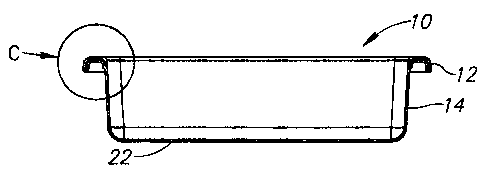Some of the information on this Web page has been provided by external sources. The Government of Canada is not responsible for the accuracy, reliability or currency of the information supplied by external sources. Users wishing to rely upon this information should consult directly with the source of the information. Content provided by external sources is not subject to official languages, privacy and accessibility requirements.
Any discrepancies in the text and image of the Claims and Abstract are due to differing posting times. Text of the Claims and Abstract are posted:
| (12) Patent Application: | (11) CA 2591109 |
|---|---|
| (54) English Title: | SILICONE BAKING PAN |
| (54) French Title: | PLATEAU DE CUISSON AU FOUR DE SILICONE |
| Status: | Deemed Abandoned and Beyond the Period of Reinstatement - Pending Response to Notice of Disregarded Communication |
| (51) International Patent Classification (IPC): |
|
|---|---|
| (72) Inventors : |
|
| (73) Owners : |
|
| (71) Applicants : |
|
| (74) Agent: | SMART & BIGGAR LP |
| (74) Associate agent: | |
| (45) Issued: | |
| (22) Filed Date: | 2007-06-08 |
| (41) Open to Public Inspection: | 2007-12-09 |
| Examination requested: | 2010-06-01 |
| Availability of licence: | N/A |
| Dedicated to the Public: | N/A |
| (25) Language of filing: | English |
| Patent Cooperation Treaty (PCT): | No |
|---|
| (30) Application Priority Data: | ||||||
|---|---|---|---|---|---|---|
|
A mold is integrally formed from a flexible material that is suitable for
baking or
molding food products, such as food grade silicone. In one example, the mold
includes a rim
at the top and a wall extending between the rim and a base at the bottom. The
wall is
sufficiently thick that the pan can support its own weight while holding a
food item. The
mold may include an interior or exterior relief pattern that is imparted onto
the food item. In
some forms, an upper portion of the mold is relatively smooth and more
flexible than a lower
portion having a relief pattern. An internal U-shaped stiffening element helps
to prevent the
mold from collapsing and improves handling of the mold.
Note: Claims are shown in the official language in which they were submitted.
Note: Descriptions are shown in the official language in which they were submitted.

2024-08-01:As part of the Next Generation Patents (NGP) transition, the Canadian Patents Database (CPD) now contains a more detailed Event History, which replicates the Event Log of our new back-office solution.
Please note that "Inactive:" events refers to events no longer in use in our new back-office solution.
For a clearer understanding of the status of the application/patent presented on this page, the site Disclaimer , as well as the definitions for Patent , Event History , Maintenance Fee and Payment History should be consulted.
| Description | Date |
|---|---|
| Inactive: IPC expired | 2016-01-01 |
| Application Not Reinstated by Deadline | 2014-04-15 |
| Inactive: Dead - No reply to s.30(2) Rules requisition | 2014-04-15 |
| Deemed Abandoned - Failure to Respond to Maintenance Fee Notice | 2013-06-10 |
| Inactive: Abandoned - No reply to s.30(2) Rules requisition | 2013-04-15 |
| Inactive: S.30(2) Rules - Examiner requisition | 2012-10-15 |
| Amendment Received - Voluntary Amendment | 2012-05-18 |
| Inactive: S.30(2) Rules - Examiner requisition | 2011-11-21 |
| Amendment Received - Voluntary Amendment | 2010-11-29 |
| Letter Sent | 2010-06-15 |
| Request for Examination Requirements Determined Compliant | 2010-06-01 |
| Request for Examination Received | 2010-06-01 |
| All Requirements for Examination Determined Compliant | 2010-06-01 |
| Inactive: Cover page published | 2007-12-09 |
| Application Published (Open to Public Inspection) | 2007-12-09 |
| Inactive: IPC assigned | 2007-08-07 |
| Inactive: First IPC assigned | 2007-08-07 |
| Inactive: IPC assigned | 2007-08-07 |
| Inactive: Filing certificate - No RFE (English) | 2007-07-18 |
| Filing Requirements Determined Compliant | 2007-07-18 |
| Application Received - Regular National | 2007-07-11 |
| Abandonment Date | Reason | Reinstatement Date |
|---|---|---|
| 2013-06-10 |
The last payment was received on 2012-04-16
Note : If the full payment has not been received on or before the date indicated, a further fee may be required which may be one of the following
Please refer to the CIPO Patent Fees web page to see all current fee amounts.
| Fee Type | Anniversary Year | Due Date | Paid Date |
|---|---|---|---|
| Application fee - standard | 2007-06-08 | ||
| MF (application, 2nd anniv.) - standard | 02 | 2009-06-08 | 2009-03-09 |
| MF (application, 3rd anniv.) - standard | 03 | 2010-06-08 | 2010-05-26 |
| Request for examination - standard | 2010-06-01 | ||
| MF (application, 4th anniv.) - standard | 04 | 2011-06-08 | 2011-03-16 |
| MF (application, 5th anniv.) - standard | 05 | 2012-06-08 | 2012-04-16 |
Note: Records showing the ownership history in alphabetical order.
| Current Owners on Record |
|---|
| PROGRESSIVE INTERNATIONAL CORP. |
| Past Owners on Record |
|---|
| SASCHA KAPOSI |